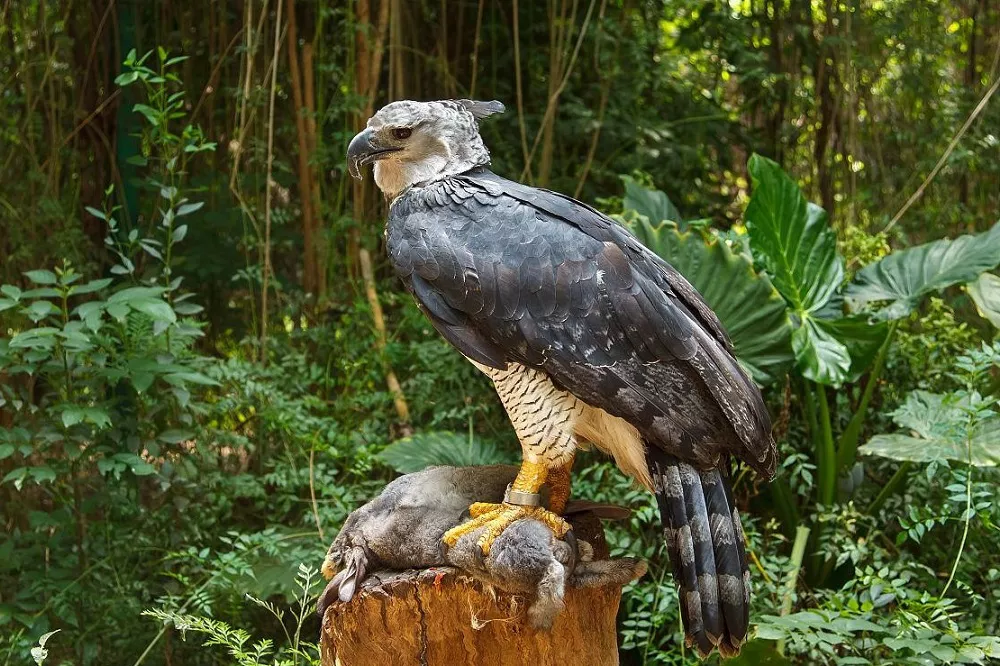In the realm of the avian kingdom, few creatures command as much awe and respect as the Harpy Eagle (Harpia harpyja). Known as the “King of the Forest,” this magnificent bird of prey has captured the imagination of naturalists and enthusiasts worldwide. With its extraordinary size, power, and striking appearance, the Harpy Eagle stands as a symbol of the beauty and diversity of our planet’s ecosystems. In this article, we will explore the unique characteristics, habitat, and significance of the Harpy Eagle, shedding light on why it is considered one of the most remarkable raptors on Earth.
Physical Characteristics:
The Harpy Eagle is an impressive and majestic bird, boasting a combination of grace and strength. It is among the largest and most powerful eagles in the world. Adult individuals can reach an imposing height of 89 centimeters (35 inches) and have a wingspan that can exceed two meters (over six feet). Females are significantly larger than males, with some females weighing up to nine kilograms (20 pounds).
This remarkable species possesses distinct physical features that contribute to its commanding presence. Its most notable characteristic is a prominent double crest of feathers on its head, giving it a regal and distinctive appearance. The Harpy Eagle’s plumage is predominantly dark gray on the upper body, while the underparts are mostly white. Its large, powerful talons are well-adapted for capturing and subduing prey.
Habitat and Range:
The Harpy Eagle is primarily found in tropical rainforests, occupying a range that stretches from Central and South America, including countries such as Brazil, Panama, and Venezuela. It has a preference for undisturbed primary forests with tall canopy trees, where it can find suitable nesting sites and an abundance of prey.
This magnificent species relies on large tracts of intact forest habitat, making it highly susceptible to habitat loss and fragmentation. Deforestation poses a significant threat to Harpy Eagle populations, as it diminishes their available nesting sites and reduces prey availability. Conservation efforts are crucial to ensuring the survival of this iconic bird in its natural habitat.
Predatory Abilities:
The Harpy Eagle is an apex predator, occupying the top of the rainforest food chain. Its hunting prowess and adaptations make it a formidable predator. The primary diet of the Harpy Eagle consists of sloths, monkeys, tree-dwelling mammals, and large birds. Its large size and powerful talons allow it to capture and carry off prey weighing up to seven kilograms (15 pounds).
The Harpy Eagle’s hunting strategy often involves patiently perching high in the forest canopy, surveying the surroundings for potential prey. Once a suitable target is identified, it executes a swift and precise attack, using its powerful talons to immobilize and capture the prey. Its broad wings and short, rounded tail provide agility and maneuverability within the dense forest environment.
Behavior and Mating:
Harpy Eagles are solitary birds, and they spend most of their time in the treetops of the rainforest canopy. They are highly territorial and will defend their hunting grounds aggressively against other predatory birds. During mating season, males perform elaborate courtship displays to attract females. Harpy Eagles mate for life and will return to the same nesting site year after year to raise their young. Females lay a single egg at a time, which both parents take turns incubating and caring for.
Conservation Status:
The Harpy Eagle is listed as Near Threatened on the International Union for Conservation of Nature (IUCN) Red List. The species faces significant threats due to habitat loss, illegal hunting, and disturbance in its forested habitats. Efforts are underway to protect and conserve Harpy Eagles through initiatives such as habitat preservation, community engagement, and captive breeding programs.
The Harpy Eagle’s conservation is not only crucial for the species’ survival but also for the preservation of the delicate balance of the rainforest ecosystem. By safeguarding the habitat and protecting this apex predator, we contribute to the conservation of numerous other species that rely on healthy forest habitats.
Conclusion:
The Harpy Eagle, with its impressive size, majestic appearance, and role as a top predator, holds a special place in the natural world. Its presence signifies the vitality and grandeur of the rainforest ecosystems it calls home. Understanding the unique characteristics, habitat requirements, and conservation needs of the Harpy Eagle allows us to appreciate the importance of protecting this magnificent species and the intricate web of life it represents. Through collaborative efforts and conservation actions, we can ensure the continued existence of the Harpy Eagle as a symbol of our planet’s rich biodiversity and natural heritage.


 Facebook
Facebook  Instagram
Instagram  Youtube
Youtube 